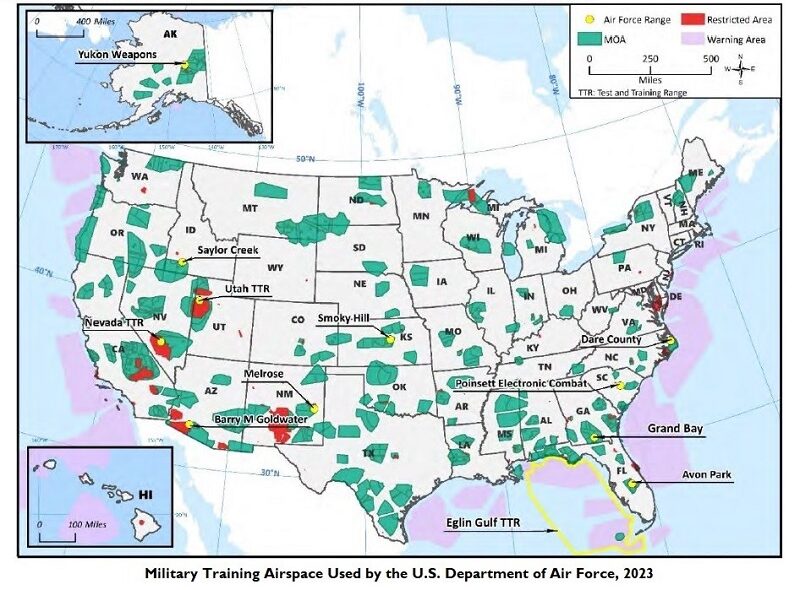
In August 2023, the U.S. Department of Defense issued a legislatively-required report to Congress on the uses of per- and polyfluoroalkyl substances (PFAS) that the military considers “critical to the national security of the United States.” The detailed 27-page report contains a single reference to chaff – identifying it as a kinetic (active warfare) capability requiring a “direct use of PFAS.” The report affirms that PFAS is an “ingredient” in chaff.[1][2]
 Radio frequency chaff is a defensive countermeasure that is deployed in approved training airspace to reflect adversary radar signals and permit an aircraft to avoid simulated radar-guided missiles.
Radio frequency chaff is a defensive countermeasure that is deployed in approved training airspace to reflect adversary radar signals and permit an aircraft to avoid simulated radar-guided missiles.
In 2002, the National Institutes of Health reported that at least 500 tons of chaff was released annually during training within selected military operating areas in the United States.[3] Chaff may be deployed from an aircraft or may be launched from a surface vessel.[4]
Chaff consists of aluminum-coated glass fibers (also referred to as dipoles) ranging in lengths from 0.8 to 0.75 cm. Chaff is released or dispensed from military vehicles in cartridges or projectiles that contain millions of dipoles. When deployed, a diffuse cloud of dipoles is formed that is undetectable to the human eye. Chaff is a very light material that can remain suspended in air anywhere from 10 minutes to 10 hours and can travel considerable distances from its release point, depending on prevailing atmospheric conditions.[5]
Kapton[6] is a plastic wrapping material used in delayed opening combat chaff for testing use at approved military aircraft training ranges and in combat outside the continental United States.[7] Kapton general-purpose flexible film is coated or laminated on one or both sides with a fluoropolymer (Teflon).[8][9] In 2023, the Air Force reported that “less than 1.0 percent of the total annual chaff deployed will have Kapton wrapping.”[10]
Not all chaff is wrapped in PFAS. The military also utilizes parchment paper-wrapped bundles of delayed opening training chaff. In 2011, the Department of Air Force reported that the residual Kapton wrapping was determined to have a potential for environmental impacts. Biodegradable parchment paper-wrapping for delayed opening chaff was developed for military training to limit the potential impacts from Kapton wrapping falling in a marine environment.[11] A Kapton-based film wrapping would persist in a marine environment and could be perceived by marine predators as a food source.[12]
The U.S. Department of Air Force recently reported that Kapton is persistent in the environment, and use of Kapton-wrapped chaff for anything other than testing or limited training would result in “substantial quantities” of the polyimide film being deposited on the (seawater) surface. To limit potential environmental impacts, Kapton-wrapped combat chaff is “not deployed over marine environments during testing or limited training.”[13]
The US Department of Air Force defines “legacy” chaff and flare units as those deployed during the past 40 years.[14] Unless challenged, PFAS-laden chaff will continue to be part of our future.
Published by Citizens for Safe Water Around Badger (CSWAB), 9 February 2024.
FOOTNOTES:
[1] Office of the Assistant Secretary of Defense for Energy, Installations, and Environment Office of the Assistant Secretary of Defense for Industrial Base Policy, Report on Critical Per- and Polyfluoroalkyl Substance Uses Pursuant to Section 347 of the James M. Inhofe National Defense Authorization Act for Fiscal Year 2023 (Public Law 117-26), August 2023.
[2] FINAL SUPPLEMENTAL REPORT UPDATE ENVIRONMENTAL EFFECTS OF TRAINING WITH DEFENSIVE COUNTERMEASURES, prepared for: Air Force Civil Engineer Center by U.S. Army Corps of Engineers, Appendix A, March 2023.
[3] Arfsten DP, Wilson CL, Spargo BJ, Radio frequency chaff: the effects of its use in training on the environment. Ecotoxicol Environ Saf. 2002 Sep;53(1):1-11. doi: 10.1006/eesa.2002.2197. PMID: 12481850.https://pubmed.ncbi.nlm.nih.gov/12481850/
[4] Atlantic Fleet Training and Testing Draft Environmental Impact Statement/Overseas Environmental Impact Statement, June 2017.
[5] D.P. Arfsten, C.L. Wilson, B.J. Spargo, Human and Environmental Health Issues Related to Use of Radio Frequency Chaff, Navy Medicine, Volume 92, No. 5 (Sept-Oct 2001):12-16. https://cswab.org/wp-content/uploads/2021/11/Chaff-Human-and-Environmental-Health-Issues-Paper-Arfsten-et-al-2001-1.pdf
[6] Dupont. (2000). Kapton Polyimide Film. Bulletin GS-96-7 (as cited in the Final PROGRAMMATIC ENVIRONMENTAL ASSESSMENT FOR TESTING AND TRAINING WITH DEFENSIVE COUNTERMEASURES, United States Department of the Air Force, December 2023).
[7] FINAL SUPPLEMENTAL REPORT UPDATE ENVIRONMENTAL EFFECTS OF TRAINING WITH DEFENSIVE COUNTERMEASURES, prepared for: Air Force Civil Engineer Center by U.S. Army Corps of Engineers, Appendix A, (starts on page 113 of 320), March 2023. https://www.airforcechaffandflareprogrammaticea.com/documents/Clean_Final%20PEA_Chaff-Flare_Dec%202023_wFONSI_reducedsize.pdf
[8] Fluoropolymers are a group of polymers within the class of per- and polyfluoroalkyl substances (PFAS).
[9] Kapton is a registered trademark of DuPont in the United States. Reference: DuPont Kapton Polyimide Film data sheet, undated. https://www.dupont.com/electronics-industrial/kapton-fn.html
[10] FINAL SUPPLEMENTAL REPORT UPDATE ENVIRONMENTAL EFFECTS OF TRAINING WITH DEFENSIVE COUNTERMEASURES, prepared for: Air Force Civil Engineer Center by U.S. Army Corps of Engineers, Appendix A, March 2023.
[11]Final PROGRAMMATIC ENVIRONMENTAL ASSESSMENT FOR TESTING AND TRAINING WITH DEFENSIVE COUNTERMEASURES, United States Department of the Air Force, December 2023.
[12] FINAL SUPPLEMENTAL REPORT UPDATE ENVIRONMENTAL EFFECTS OF TRAINING WITH DEFENSIVE COUNTERMEASURES, prepared for: Air Force Civil Engineer Center by U.S. Army Corps of Engineers, Appendix A, March 2023.
[13] FINAL SUPPLEMENTAL REPORT UPDATE ENVIRONMENTAL EFFECTS OF TRAINING WITH DEFENSIVE COUNTERMEASURES, prepared for: Air Force Civil Engineer Center by U.S. Army Corps of Engineers, Appendix A, March 2023.
[14] U.S. Department of Air Force, Testing and Training with Defensive Countermeasures Programmatic EA, Project Description, 2023. https://www.airforcechaffandflareprogrammaticea.com/project_overview.aspx
